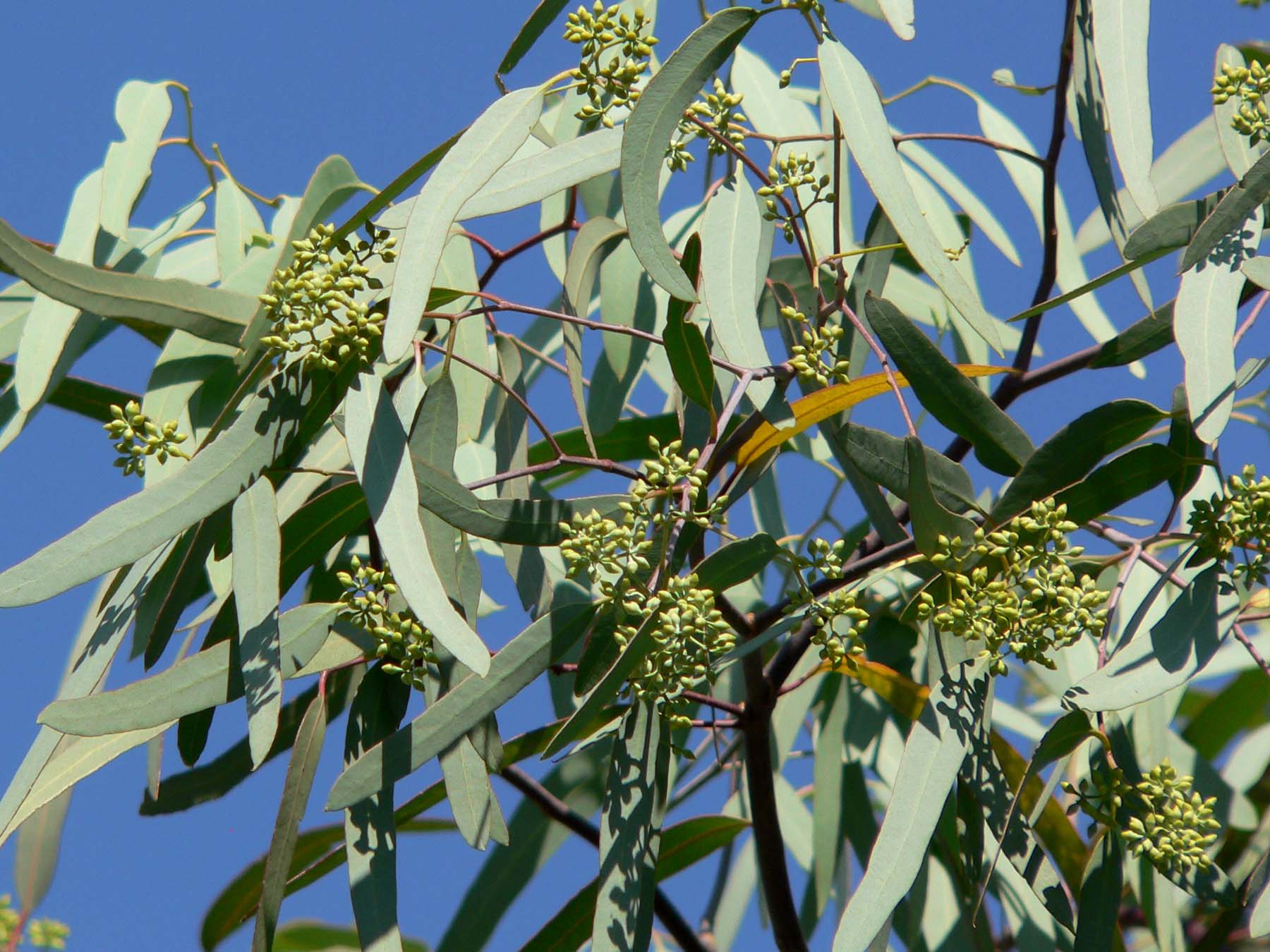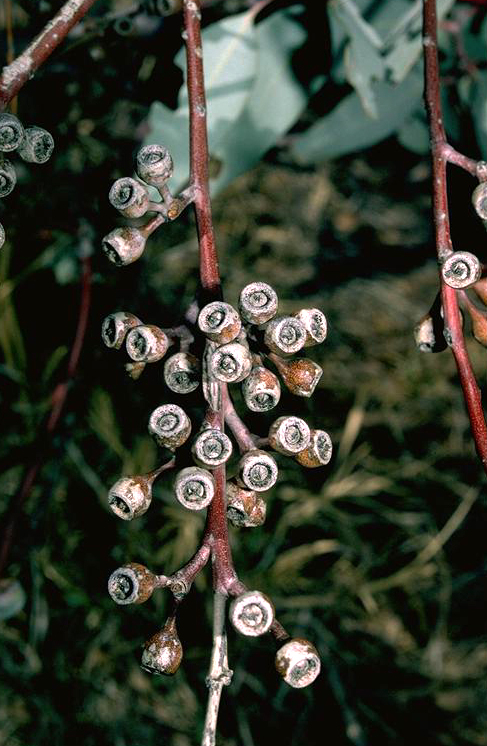Eucalyptus Microtheca on:
[Wikipedia]
[Google]
[Amazon]

 ''Eucalyptus microtheca'', with many common names including desert box, coolibah, callaille, targoon, yathoo or coolabah, is a species of tree that is
''Eucalyptus microtheca'', with many common names including desert box, coolibah, callaille, targoon, yathoo or coolabah, is a species of tree that is

 ''Eucalyptus microtheca'', with many common names including desert box, coolibah, callaille, targoon, yathoo or coolabah, is a species of tree that is
''Eucalyptus microtheca'', with many common names including desert box, coolibah, callaille, targoon, yathoo or coolabah, is a species of tree that is endemic
Endemism is the state of a species being found only in a single defined geographic location, such as an island, state, nation, country or other defined zone; organisms that are indigenous to a place are not endemic to it if they are also foun ...
to northern Australia. It has rough, flaky or fibrous bark on the trunk and branches, lance-shaped adult leaves, flower buds in groups of seven, white flowers and spherical to conical fruit. It is widely distributed from the Kimberley
Kimberly or Kimberley may refer to:
Places and historical events
Australia
Queensland
* Kimberley, Queensland, a coastal locality in the Shire of Douglas
South Australia
* County of Kimberley, a cadastral unit in South Australia
Ta ...
region of Western Australia to Cape York in Queensland.
Description
''Eucalyptus microtheca'' is a tree, sometimes a mallee, that typically grows to a height of and forms alignotuber
A lignotuber is a woody swelling of the root crown possessed by some plants as a protection against destruction of the plant stem, such as by fire. Other woody plants may develop basal burls as a similar survival strategy, often as a respons ...
. It has a whitish grey to dark grey, box-type bark that is often deeply fissured, coarsely flaky or tessellated as it ages. Young plants and coppice
Coppicing is the traditional method in woodland management of cutting down a tree to a tree stump, stump, which in many species encourages new Shoot (botany), shoots to grow from the stump or roots, thus ultimately regrowing the tree. A forest ...
regrowth have narrow lance-shaped leaves that are long, wide and petiolate. Adult plants have leaves that are the same shade of dull green to bluish on both sides, lance-shaped to curved, long and wide, tapering to a petiole long. The flower buds are arranged on a thin, branched peduncle in groups of seven, the peduncle long, the individual buds on pedicels
In botany, a pedicel is a stem that attaches a single flower to the inflorescence
In botany, an inflorescence is a group or cluster of flowers arranged on a plant's Plant stem, stem that is composed of a main branch or a system of branch ...
long. Mature buds are pear-shaped to oval or spherical, long and wide with a rounded operculum with a point in the centre. Flowering occurs between September and January and the flowers are white. The fruit is a woody, shortened spherical or conical capsule long and wide with the valves near rim level.
Taxonomy and naming
''Eucalyptus microtheca'' was first formally described in 1859 byFerdinand von Mueller
Baron Sir Ferdinand Jacob Heinrich von Mueller, (; 30 June 1825 ŌĆō 10 October 1896) was a German-Australian physician, geographer, and most notably, a botanist. He was appointed government botanist for the then colony of Victoria, Australia ...
in the '' Journal of the Proceedings of the Linnean Society, Botany'', from samples he had collected in 1855 along the Victoria River in the Northern Territory. The specific epithet
In Taxonomy (biology), taxonomy, binomial nomenclature ("two-term naming system"), also called binary nomenclature, is a formal system of naming species of living things by giving each a name composed of two parts, both of which use Latin gramm ...
(''microtheca'') is from the Greek ''micro-'' meaning "small" and ''thece'' meaning "a box" referring to the small fruit.
''Eucalyptus microtheca'' is most closely related to the widespread '' E. coolabah'' which is found in similar but drier habitats to the south and south-east. It is also closely related to '' E. victrix'' which is found in even drier habitats from central Australia west to the Pilbara
The Pilbara () is a large, dry, sparsely populated regions of Western Australia, region in the north of Western Australia. It is known for its Indigenous Australians, Aboriginal people; wealth disparity; its ancient landscapes; the prevailing r ...
region of Western Australia.
Distribution and habitat
The tree is distributed widely across northern Australia and mostly found along river banks and in the heavy soils of flood plains. It is the second most widely distributed species in Australia after ''Eucalyptus camaldulensis
''Eucalyptus camaldulensis'', commonly known as river red gum, is a flowering plant in the family Myrtaceae, and is Endemism, endemic to Australia. It is a tree with smooth white or cream-coloured bark, lance-shaped or curved adult leaves, flow ...
''.
The species is found waterlogged flats, along the margins of swamps in the Kimberley
Kimberly or Kimberley may refer to:
Places and historical events
Australia
Queensland
* Kimberley, Queensland, a coastal locality in the Shire of Douglas
South Australia
* County of Kimberley, a cadastral unit in South Australia
Ta ...
region of Western Australia
Western Australia (WA) is the westernmost state of Australia. It is bounded by the Indian Ocean to the north and west, the Southern Ocean to the south, the Northern Territory to the north-east, and South Australia to the south-east. Western Aust ...
. Populations of the tree are scattered through several IBRA
The Interim Biogeographic Regionalisation for Australia (IBRA) is a biogeography, biogeographic regionalisation of Australia developed by the Australian government's Department of Sustainability, Environment, Water, Population and Communities ( ...
regions including Dampierland
Dampierland is an interim Australian bioregion in Western Australia
Western Australia (WA) is the westernmost state of Australia. It is bounded by the Indian Ocean to the north and west, the Southern Ocean to the south, the Northern Territo ...
, Northern Kimberley
The Northern Kimberley, an interim Australian bioregion, is located in the northern Kimberley region of Western Australia,Central Kimberley
The Central Kimberley, an interim Australian bioregion, is located in the central Kimberley region of Western Australia
Western Australia (WA) is the westernmost state of Australia. It is bounded by the Indian Ocean to the north and west, t ...
, Ord Victoria plain
The Ord Victoria Plain, an interim Australian bioregion, is located in the Northern Territory and Western Australia, comprising .
and Victoria Bonaparte
The Victoria Bonaparte, an interim Australian bioregion, is located in the Northern Territory and Western Australia,
. It is also distributed throughout the top end
The Top End of Australia's Northern Territory is a geographical region encompassing the northernmost section of the Northern Territory, which aside from the Cape York Peninsula is the northernmost part of the Australian continent. It covers a ...
of the Northern Territory
The Northern Territory (abbreviated as NT; known formally as the Northern Territory of Australia and informally as the Territory) is an states and territories of Australia, Australian internal territory in the central and central-northern regi ...
east from the Western Australian border as far north as about Newcastle Waters
Newcastle Waters is a town and locality off the Stuart Highway in the Northern Territory. It is classified as a ghost town that contains a number of preserved historic buildings, including Jones's Store and the Junction Hotel.
Geography
no ...
and through the Barkly Tableland
The Barkly Tableland is a region in the Central East of the Northern Territory, extending into Western Queensland. The region was named after Sir Henry Barkly. The epithet "Tableland" is inaccurate, since the region is neither elevated relative ...
east through the catchment areas of the Roper Roper is a craftsman who makes ropes; a ropemaker.
It may also refer to:
Places
*Roper, North Carolina, USA
*Roper River, Northern Territory, Australia
People
* Roper (surname)
Other
*'' Roper v. Simmons'', a decision of the United States Su ...
and McArthur River
The McArthur River is a river in the Northern Territory of Australia which flows into the Gulf of Carpentaria at Port McArthur, opposite the Sir Edward Pellew Group of Islands. The river was named by Ludwig Leichhardt while he explored the a ...
s and into the Gulf Country
The Gulf Country or North West Queensland is the region of woodland and savanna grassland surrounding the Gulf of Carpentaria in north western Queensland and eastern Northern Territory on the north coast of Australia. The region is also ca ...
of Queensland
Queensland ( , commonly abbreviated as Qld) is a States and territories of Australia, state in northeastern Australia, and is the second-largest and third-most populous state in Australia. It is bordered by the Northern Territory, South Austr ...
. In Queensland the range of the plant extends from the Gulf Country to western Cape York and south to about Mount Isa
Mount Isa ( ) is a city in the Gulf Country region of Queensland, Australia. It came into existence because of the vast mineral deposits found in the area. Mount Isa Mines (MIM) is one of the most productive mines in world history, based on co ...
.
Uses
Indigenous Australian
Indigenous Australians are people with familial heritage from, or recognised membership of, the various ethnic groups living within the territory of contemporary Australia prior to History of Australia (1788ŌĆō1850), British colonisation. The ...
s harvested seeds from ''E. microtheca'' as a source of food.
The wood produced by the tree is extremely hard and difficult to work with but is excellent for firewood and makes long-lasting fence posts that resist weathering and insects. The trees have a dense, rounded shape making them wind resistant and useful as windbreak
A windbreak (shelterbelt) is a planting usually made up of one or more rows of trees or shrubs planted in such a manner as to provide shelter from the wind and to protect soil from erosion. They are commonly planted in hedgerows around the ed ...
s and to control erosion
Erosion is the action of surface processes (such as Surface runoff, water flow or wind) that removes soil, Rock (geology), rock, or dissolved material from one location on the Earth's crust#Crust, Earth's crust and then sediment transport, tran ...
. They are one of the more commonly planted eucalyptus species in the southwestern United States since they are fast and easy to grow. Able to tolerate full sun, withstand temperatures below freezing and grow in soils with poor fertility makes them easy to grow.
Oils extracted from the leaves and blossom of the plant contain 101 compounds including ╬▒-pinene, O-cymen, ╬▓-pinene, aromadendrene, ╬▒-phellandrene and globulol. Some of the chemicals isolated are utilised in medicinal and food products and others are alternatives to insecticide
Insecticides are pesticides used to kill insects. They include ovicides and larvicides used against insect eggs and larvae, respectively. The major use of insecticides is in agriculture, but they are also used in home and garden settings, i ...
agents.
References
{{Taxonbar, from=Q928175 microtheca Drought-tolerant trees Myrtales of Australia Plants described in 1859 Taxa named by Ferdinand von Mueller